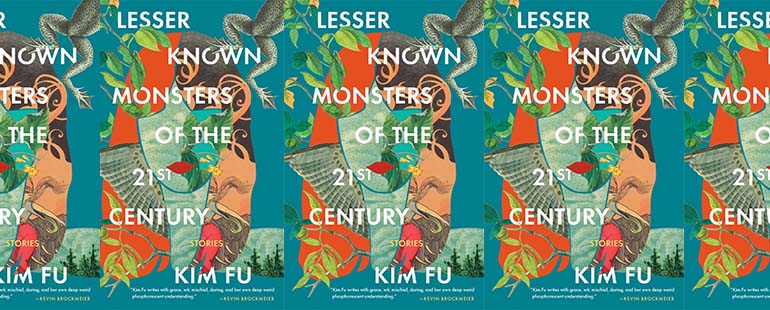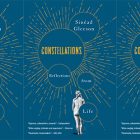The Real and the Unreal in Lesser Known Monsters of the 21st Century

In “Liddy, First to Fly,” the second story in Kim Fu’s Lesser Known Monsters of the 21st Century, released in early February, the narrator, Grace, observes that for her and her friends, all on the cusp of adolescence, “The realm of pretend had only just closed its doors to us, and light still leaked through around the edges.” The fact that their friend Liddy seemed to be growing wings from her ankles was thus not so extraordinary. To adults, though—it almost goes without saying—this fact would seem to be a crisis, something to splash on the covers of magazines or report on at length in medical journals. But perhaps the wings would simply disappear under this collective adult gaze. As Grace explains, “One adult can be lured into pretend, can taste the tea in our toy cup, hear the voice on the toy phone. One adult could have seen what we saw and carried it quietly within her forever. But not four…Four adults can talk to each other until reality straightens, until doubt is crushed, until their memories unstitch and reform.” Fu’s collection, however, demonstrates that reality may be stranger than we’d like to admit, and that the light never stops leaking from the realm of pretend.
The interplay of fantasy and reality in Fu’s stories takes a variety of forms. In “June Bugs,” an infested house embodies the terror of the abusive relationship the main character is trying to escape. In “Sandman,” the titular character courts the insomniac protagonist in vivid, unpredictable dreams. In “In This Fantasy,” the narrator simply shares her fantasies—daydreams in which she spins fictional lives for herself, much as any storyteller might do. A few of the stories in the collection involve technologies that make fantasies real—or so verisimilar that they are indistinguishable from what is real. In “Twenty Hours,” for example, the wealthy have access to 3D printers that, in concert with full-body scanners and capacious data storage, make it possible to print out another copy of your wife after you’ve killed her. Why kill your wife? Among other reasons, the possession of such a printer is a temptation in itself; as the narrator muses, “the parties of the ultrarich must be bloodbaths.” And in “Time Cubes,” an inventor sells transparent cubes whose contents—a plant in one model, a frog in a more expensive model—come to life, age, and wither, or, if a dial on the side or the cube is turned in another direction, become younger and shrink down to a sprout or tadpole. The main character, a Depressive Insider (“the latter designation meaning she did not leave the Mall,” beyond whose walls the world appears to be uninhabitable anyway), finds in a variant of the inventor’s unsettling toy a way to escape from dystopia.
It is one thing to fantasize about murders and violent deaths, as the storytelling narrator of “In This Fantasy” does; it is another thing to have a simulator hooked into your brain, creating a fantasy so seemingly real and immersive that you might be fooled into forgetting that your mother is dead, as is possible in “Pre-simulation Consultation XF007867.” This story, the first in the collection, engages directly with questions about fantasies—which fantasies are ethical, what they might cost us, and what we want from them. The story is the transcript of a conversation between a simulation operator and a first-time client, who wants to experience a simulation of walking in a botanical garden with her now-dead mother. Unfortunately, as the operator reminds the client, “the simulation can’t include deceased individuals you knew personally. It’s in the handbook.” In response to the client’s questions (“What? Why?”), the operator adds, “It has proven to be too addictive.” The simulation, the operator explains, “requires you to have a firm grasp on what is and isn’t real. We need clients to make a clean exit, such that the end of the simulation is akin to closing the book, turning off the console, walking out of the theater.” As the conversation proceeds, it becomes clear that many clients are unable to make this “clean exit.” “A small number of clients make up the majority of our business,” says the operator, “The ‘whales,’ rich people who come as much as they can afford, and then some. People who come every day until they’re bankrupt.” In truth, the operator admits, it’s not just simulations including loved ones who have passed that are addictive—any simulation is addictive. But the bereaved especially may “choose to forsake the real world and all its sorrows” for a fantasy of living “just one ordinary day without grief.”
Even as it hints at the dangers of certain kinds of fantasies, the story is an affirmation of the solace that can be found in fictional experiences, including—especially—fictional experiences that are not fantastic, such as the experience the client wishes to have with (a simulation of) their mother:
We’re walking through the gardens together. She’s holding my arm. She’s telling me plant facts, boring ones, like “Did you know bamboo can grow a full inch in just an hour?” And she’s gossiping about relatives I don’t remember, and kids I went to elementary school with. “Little Russell is a newscaster now! Aunt Sandy is pregnant!” That sort of thing. And I’m just listening. I say things like, “That’s interesting,” and “Russell did love to hear himself talk.” I’m not getting snide or impatient, or looking at my phone, or thinking about work, or picking a fight.
The operator understands the longing that the client wants to fulfill through this experience: their longing to be “patient and kind and present as you wish you had been, just once.”
The question is whether—and for whom—having this kind of experience just once can be enough. At any rate, just once is all that the client will be afforded, as is the case with the clients of Allie, the main character of “Do You Remember Candy,” the final story in the book. This story deals with the aftermath of a crisis in which, for unknown reasons, every person on Earth lost their sense of taste. Allie starts a business creating experiences through which her clients can remember the foods they miss the most, such as, for one woman, an underripe pear:
In Allie’s office, the woman shimmies into the miniature plant house, feet-first. Allie hands her the slippery, silken wooden dowel, now coated with menthol oil that sucks the heat from her fingers. Allie reaches inside and briefly feels for the contours of the woman’s features, then lays a cool, wet cloth over her face. Allie had experimented with different exotic fabrics but found the slightly rough, cheap dishcloths she already had in her kitchen worked best. She counts to thirty, removes the dishcloth, and then—again first locating the woman’s mouth by touch—uses her index finger to apply a thin coat of honey thinned with vodka to her lips.
I read this passage to my husband, an artist, to ask him what kind of art Allie is making—conceptual art? Installation art? Performance art for an audience of one? (One character in the story suggests that Allie’s is an art of an entirely different kind—that she might be a con artist.) The art is a kind of theater, my husband said, and also a kind of sacrament—a ritual connecting the subject to the divine. The forgotten divine, the longed-for divine, the ordinary divine—“grandmother’s father’s sister’s best friend’s chocolate barbecued kimchi parathas pumpkin pie stew”—this is what Fu’s characters seek through their fantasies, technologies, and dreams.



